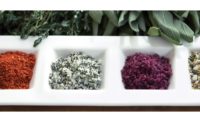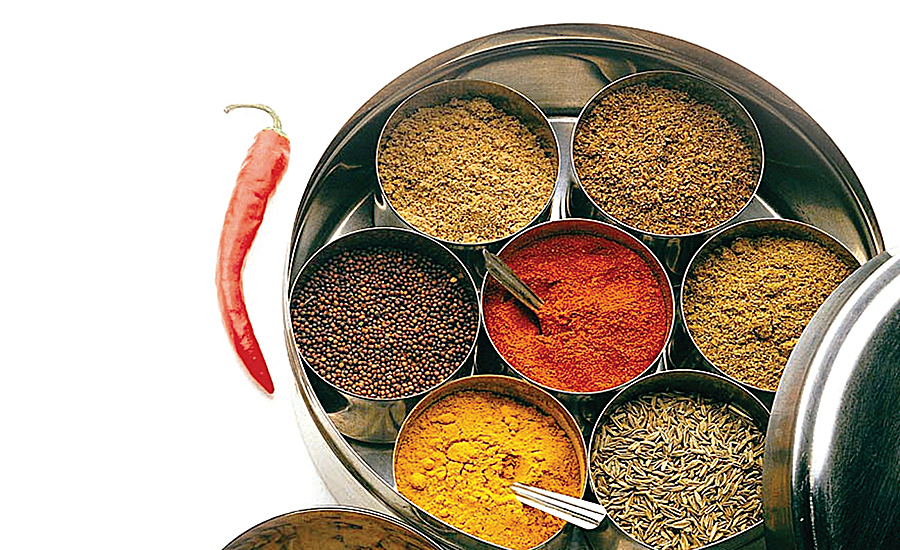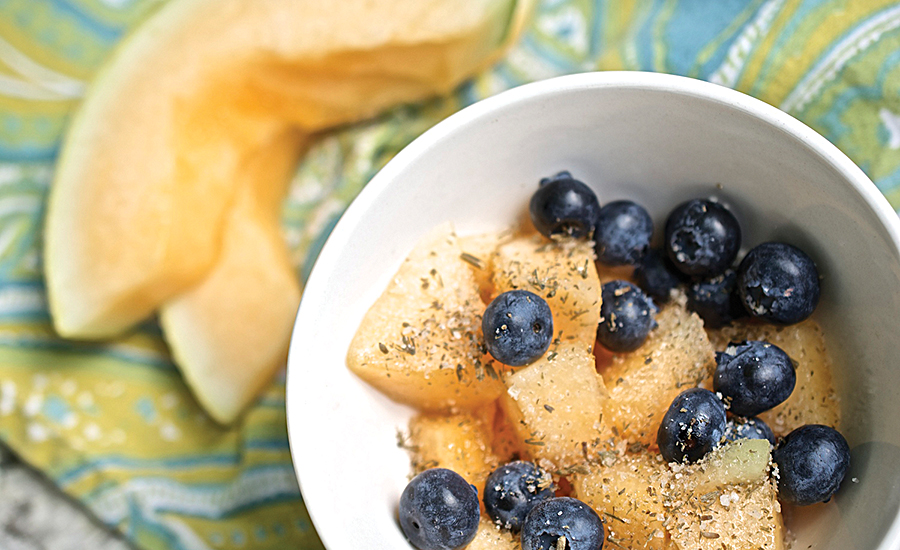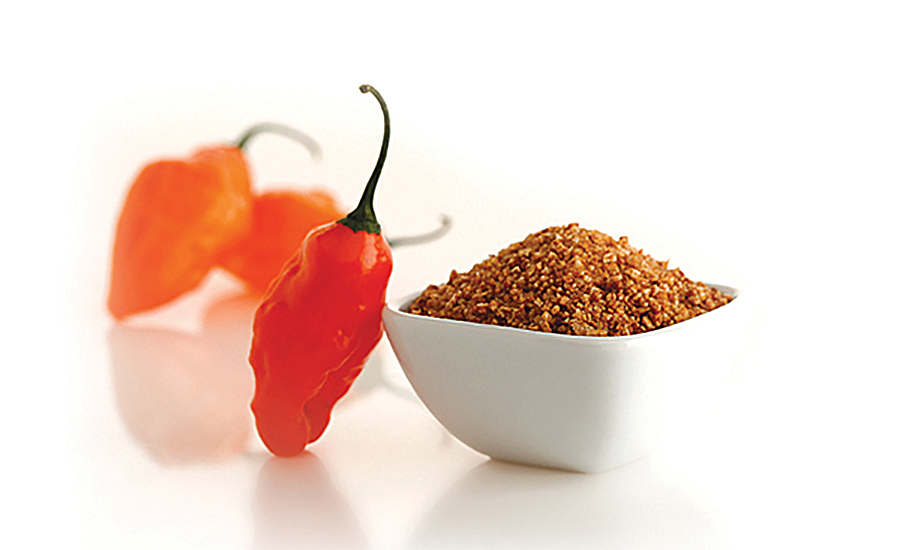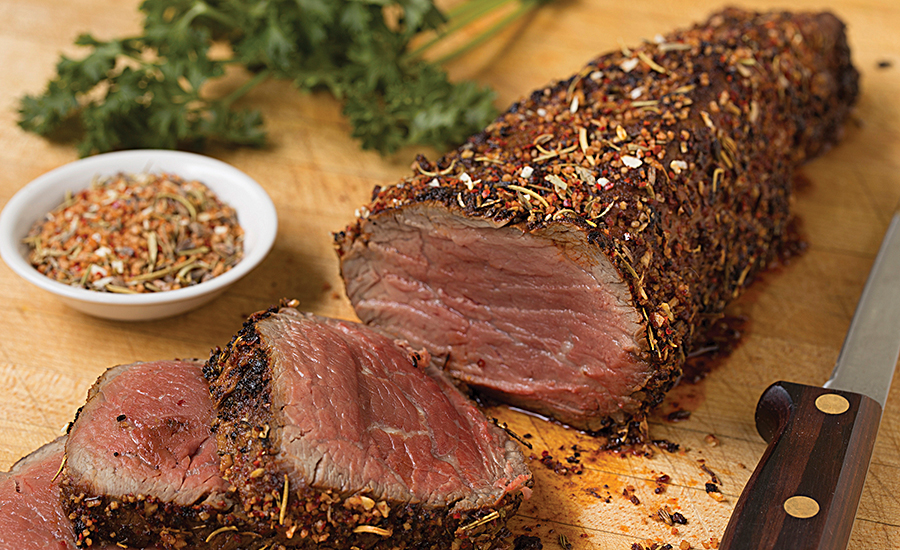Spices Spark Food Products Development
Spices grab consumer attention and hit the palate with exciting bursts of flavor

SOURCE: Wixon Inc. (www.wixon.com)

Flowers, especially lavender, are crossing over into everything from rubs to cocktails, expanding culinologists’ palettes.
SOURCE: SaltTraders LLC & Didi Davis Food (www.salttraders.com)

As fast as chili pepper trended up, so, too, did gourmet salts, making them a natural for combination in such items as chipotle-infused sea salts.
SOURCE: Saltworks/America’s Sea Salt Co. (www.seasalt.com)

Multipurpose flavor blends that can be stirred in, rubbed into or shaked on are trending strong as consumers become more knowledgable about customizing flavors.
SOURCE: Chef Robert Danhi (www.globalflavorshakers.com)

Drawing from lost traditions, the use of piquant spice in unexpected places such as bakery desserts, confections and even yogurt is coming back strong.
SOURCE: Noosa Yoghurt LLC (www.noosayoghurt.com)

Bold non-spice “spices” such as coffee and cocoa add unique flavor notes to meaty and savory formulations.
SOURCE: © 2016 by Woodland Foods Ltd. – All rights reserved (www.woodlandfoods.com)

Herbs and spices allow innumerable and subtle flavor combinations to allow processors to easily set their products apart from competitors.
SOURCE: SaltTraders LLC/photodune-Lucidwaters







It’s no secret that spices and herbs are becoming more central to today’s innovations. Consumers are constantly on the hunt for new and exciting taste sensations and seasoning combinations, from bold-flavored herbs and spices in comfort recipes to exotic, far-ranging combinations like Scoville-chart-busting chili peppers with a slab of chocolate, or basil syrup in a cocktail.
Food-trend forecasters agree that interest in new tastes are in high demand, and spicy, new flavor combinations, especially within the category of ethnic ingredients, are on the rise. The market is driven by the increasingly sophisticated diner; an influx of diverse ethnic groups; and adventurous Millennials putting their feet on the pedal of new ideas. Not only do traditional herbs, spices, and flavors (think basil, black pepper, or cinnamon) remain popular and foundational, there are several new discoveries from around the world on the horizon.
One of the more prominent examples is the Ghost chili (Bhut jolokia). One of the hottest chili peppers available, at around 1 million Scoville units (a jalapeño is about 8,000 SU) went from being little more than a dorm-room dare to appearing in sauces, snack foods, and condiments. Cardamom, once limited in this country to Indian cuisine and Scandinavian baking, is spreading out to breads and spice blends. Dried flowers, specifically lavender, are appearing in rubs and cocktails, and sumac has made inroads into prepared foods via pilafs and salad preparations.
With healthy, clean eating at the top of consumers’ minds, pure, rich flavors from spices are an important addition to any formulation. The challenge for processors is to ensure the flavors are clear and authentic in the final product. At the same time, product developers must peer into the future to respond to emerging herb and spice trends.
Topping the trend list are all types of chili peppers. Having grabbed central stage in ethnic creations, such as Thai and South Asian products, as well as all manner of savory snacks, they recently moved over to the sweet side. Hot chili peppers are incorporated into products such as cookies, cakes, cheesecakes, and chocolates, as well as beer and yogurt.
The cookie that launched Lark Fine Foods LLC was its cocoa-chili pepper Cha Cha Shortbread. While the idea of cocoa and chili pepper is not new, Lark revived the traditional blend and applied it to a cookie; that was quite new and different.
Experimenting with a base formula, former creator and owner Mary Ann McCormick tested and “bumped up the quantity and heat of cayenne pepper and also added more pep and depth by using a very spicy, high-quality cinnamon.” The success of that cookie encouraged the company to formulate new sweets with different combinations of spices and herbs, such as its Rosemary Sea Salt Shortbread.
New Directions
While the love affair with chili pepper continues, producers also have a treasure chest overflowing with options from which to choose. Fennel, lavender, cardamom, cinnamon, and peppercorns, as well as some newcomers such as amchoor, sumac, curry leaf, black cardamom, Grains of Paradise, Thai basil, and rose petals are a few of the choices from the global galaxy of spices.
Fennel seed (Foeniculum vulgare) is a staple ingredient in Indian and Italian cuisine. While the potent licorice flavor can overwhelm a formulation, when used in small quantities it brings traditional Italian flavor to tomato sauces and meat sauces. It is familiar in cuisine of the central Adriatic coast, and appears in all types of fresh sausage and salumi.
Nutmeg and mace are attached to each other, not just in many baked products, but literally. Golden brown mace is actually the outer, netlike sheath of the nutmeg seed (Myristica fragrans). While similar in flavor, mace has a lighter, slightly more floral flavor and aroma. Mace has not received much love for many years, yet with its notes of citrus and coriander, its lightness enlivens soup and baked fruit desserts.
Nutmeg, with its stronger, deeper profile, adds Old World background notes when small amounts are incorporated into béchamel or in simmering cream or white sauces used in chicken or pork.
Aside from curing a toothache with its powerful topical analgesic qualities, clove (Syzygium aromaticum) is probably best known for its use in blends for mulled cider or wine, gingerbread, and cookies. Yet its strength when used sparingly is a welcome addition to rice or other grain pilaf, especially when blended with sweet herbs and shallots or garlic.
It brings out deep spice notes and even a touch of heat.
Cultures all over the globe incorporate cumin (Cuminum cyminum) into traditional recipes. Most popularly, it is mixed with other spices in taco seasoning and other Latin dishes, as well as in Indian curry blends. Surprisingly, cumin is an underutilized spice on its own. Toasted and crushed, the spice adds an intense, warm flavor to crackers, much like the old-fashioned seed cakes. The heat-softened seeds add depth to steamed rice (especially basmati) or other pilaf dishes. And, used alongside lemon zest and garlic, cumin makes an aromatic mix for hummus or to flavor brined olives.
Versatile and aromatic cardamom (green cardamom) shows up in cuisines as diverse as Scandinavian baked goods and Indian curries. With its lemon-menthol-minty overtones, cardamom adds distinctive flavor and a rich perfume to all it touches. When mixed with black pepper and lemon zest, it makes an invigorating tea or flavoring for cookies and cakes. Or the mixture enhances fish and chicken when used as a seasoning for sautéing or high-heat roasting.
Cardamom (Elettaria cardamomum) is sold as a whole seed pod, decorticated with seeds intact, or as a powder. However, it is more delicate than other spices, with its volatile oils quickly developing an off, camphor-like flavor once exposed. It is best purchased in the pods and decorticated as needed. Purchase cardamom as needed or in small amounts, cold-stored in vacuum-sealed packages or airtight containers.
Cinnamon and Pepper
Cinnamon, like vanilla, is benefiting from recognition of terroir. There are four main varieties, Saigon, korintje, cassia (all three classified, and often referred to, confusingly, as Cassia), and Ceylon cinnamon (true cinnamon). These varieties range in flavor and strength, depending on volatile oil content. Checking in at 7% volatile oil, Saigon cinnamon (a.k.a., Vietnamese cinnamon, Cinnamomum loureiroi) adds a robust, up-front blast of the beloved spice. It not only is used in, sauces, baked goods, and desserts, but also in sauces and in phô noodle soup.
Korintje cinnamon (Indonesian or Padang cinnamon, Cinnamomum burmannii) accounts for most of the cinnamon imported into the US and is the most common type of cinnamon used by processors. Fragrant, with a smooth flavor, it is less pungent than Saigon cinnamon, yet still makes a statement in sweets, as well as when enlivening crackers and spiced nuts. Cassia (Chinese cinnamon, Cinnamomum cassia) is intense, spicy and slightly astringent. When used sparingly, it complements the savory, earthier flavors of meats and vegetables in stews and braises.
True Ceylon cinnamon (Cinnamomom zeylanicum or Cinnamomum verum) is mild and sweet, though costlier than the varieties of cassia. With its lighter, reddish-brown color and delicate flavor, it enhances the subtler flavors of lighter baked goods, dairy desserts, custards, and ice cream.
Peppercorns (Piper nigrum) come in many varieties, as well. They can be sourced with flavor profiles ranging from citrus to eucalyptus, and from mild to significant heat. “Plain old pepper” now competes with Tellicherry, Malabar, Sarawak, and the single-estate, organic Wynad peppercorns. Even pseudo-peppercorns, such as cubeb (P. cubeba), long (P. longum), and Szechuan pepper (any of scores of varieties of the genus Zanthoxylum) offer unique takes on pepper flavor and heat.
As ubiquitous as pepper is, when used for its distinct flavor profile and terroir, their subtle differences bring an authenticity to global preparations. Tellicherry and Wynad peppercorns hail from India and add a traditional spike of heat to breads such as naan and chapati. Their kick also makes a welcome addition to gingerbread and cookies, a tradition that goes back centuries.
Milder than its Indian neighbors, Malaysian Sarawak pepper, with its mingling flavors of cocoa, fruit, and woodsy spice, adds a complex note to barbecue rubs for satay and grilled meats. While cubeb peppercorns from Indonesia are used in some gin formulations, their complicated flavor—with overlays of nutmeg, camphor, and clove—gives a traditional kick to spice pastes for seafood or in a dressing with lemongrass and garlic. Long pepper from Indonesia (also smaller, less flavorful variety from India) looks like cattails and encloses a very spicy flavor, layered with hints of cardamom and nutmeg. Once revered by the Romans, this cult favorite adds a strong foundation to soup and bean dishes.
The mysterious blended flavor of Szechuan peppercorns is at once woodsy, minty, earthy, and citrusy. Cooling and tingling these peppercorns are a key ingredient in Chinese five-spice powder, adding Asian flair to blends for stir-fry and noodle dishes.
Another essential ingredient in Chinese five-spice powder is star anise (Illicium verum). It has a stronger, licorice-like flavor than European anise or fennel and is the chief ingredient in Chinese red cooking, along with soy sauce. When used in subtle amounts, its uniqueness imparts a classic Far East flavor to crackers, ice cream, or tea blends.
While not new, garlic in its dried form is a boon to processors, as it may be used in just about any application. Granulated, roasted garlic enhances blends for popcorn, tortilla chips, crackers, or croutons, adding a touch of texture. Powdered garlic melts into barbeque rubs, marinades, and tomato sauces.
New Wave
Mango powder (amchoor or amchur) is a breakout newcomer flavor crossing over from Indian cooking. It has a tangy, slightly spicy flavor with sweet, fruity overtones and a tropical aroma. It adds tartness to foods, much as Western cuisines use vinegar and lemon or lime. Made from green, unripe mangoes that are dried and ground, amchoor is commonly used to add breadth to chutney or pickles, but recently has been employed to boost flavor in toasted nut snacks and pita chips.
Looking for a lemon flavor alternative? There are several. Lemongrass (Cymbopogon citratus), lemon verbena (Aloysia citrodora), a lemon balm (Melissa officinalis), and Australian lemon myrtle (Backhousia citriodora) are a few of the tart-sweet substitutes for citrus. Perhaps the most unusual and new, Australian lemon myrtle with its sweet, citrus fragrance, is harvested and traditionally used for soap, lotion, essential oil, and lip balm.
Recently, lemon myrtle segued into the food and beverage world, especially in tea. It works quite well in desserts, such as cakes, pudding, and syrups, too. Yet in a savory application, it adds brightness to chicken and seafood preparations. Italian myrtle (Myrtus communis), a different species than lemon myrtle, has a flavor reminiscent of bay leaf with touches of juniper (Juniperus communis) and allspice (Pimenta dioica).
Italian myrtle brings broad herbal complexity to pastas, rubs, and blends for stew and braises. It also is commonly incorporated into whole grain pilafs of farro or bulgur.
Speaking of juniper, the boutique distilled spirit trend that brought exotic and flavorful gins to popularity helped bring juniper back to the table. Juniper berries are especially complementary to venison and other game meats.
Another berry, the sumac berry (from any number of fruits from the Rhus genus) has been treasured for its ruby color and tart flavor in Middle Eastern and Mediterranean cooking for millennia. A seasoning on every Persian table, the ground, dried berries add a lively, bright, citrus-like flavor to salad dressings, grain flavor packets, yogurt sauces, dipping oils, and marinades. The condiment also is used as a table seasoning for multiple savory dishes, including grilled lamb and chicken, and even eggs.
Black cardamom, while related to the more familiar green cardamom, is a toastier version of its cousin. Dried over an open fire, the spice has the menthol qualities of green cardamom, plus a smoky, nutty aroma. Added to sauces and garam masala blends, it brings an authentic flavor to Indian meat and vegetables.
Soft, sticky, chewy, with caramel-molasses-like flavor, black garlic offers a burst of umami like no other ingredient. It is fermented and aged to achieve its intriguing, intense, sweet-tart-savory goodness. While it may be eaten “raw,” it works especially well with rice, noodles, soup, dips, and dressings.
Curry leaf (from either the Murraya koenigii or Bergera koenigii trees) is not related to curry powder, which is a ground blend of a number of spices, herbs, and seeds. Used in southern Indian cooking, curry leaves typically are used fresh and sautéed in oil to bring out their flavor. Aromatic curry leaves add a pungent, lemony-herbal dimension to broths or pastes, lentil dishes, vegetarian stew, or chutney.
Grains of Paradise (Aframomum melegueta), also known as melegueta pepper, is a spice native to Africa and a member of the ginger family. The intriguing flavor is a cross between peppercorns and cardamom, with a warm, woodsy edge and just a touch of citrus. The tiny, brown seeds are ground, releasing their spicy notes, and used like black pepper. They add savory complexity to a meat rub, vinaigrettes or dressings, gingerbread, spice cakes, and fruit desserts.
Japanese shichimi togarashi is a seven-spice blend similar in concept to the Chinese five-spice powder, but not in flavor. While the Chinese five-spice powder is sweet and spicy, shichimi togarashi is spicy, savory, and nutty. A blend of chili peppers, Szechuan pepper, sesame seeds, poppy seeds, orange zest, ginger, and nori or other seaweed, shichimi togarashi brings authentic flavor to classic Japanese dishes, such as a rub for grilled meat or to season soup, noodle, or rice dishes. Or it adds spark to popcorn, crackers, dressing, dipping sauce; and to marinades with soy, toasted sesame oil, and rice wine.
Flowering Flavor
French lavender (Lavandula stoechas) is best known as a must in the classic Provençal herb blend. Used on its own in chocolates, fruit salad, and even ice cream, lavender is a powerful accent complementing citrus and sweet flavors. But lavender also enhances the earthy flavors of meat, especially lamb, when used with salt, pepper and thyme in a grill rub. Or, it can be used as a blend for roasted vegetables, such as potatoes or squashes, or even as a new flavor in fresh cheeses to be served with honey and crackers.
Joining in on the use of flowers as a spice are rose petals. Most familiar as a component in potpourri in the West, rose petals, with their floral spicy notes, are a frequent add in to Middle Eastern dishes. For savory applications, mix crushed petals with cumin, sumac, and chili for hummus or baba ganoush. On its own, rose works very well in tea blends, cookies, or shortbread, or made into syrup for cocktails.
Sweet basil (Ocimum basilicum), like pepper and cinnamon, is used in cuisines across the globe and is best known in classic Italian dishes. A lesser known member of the same species is Thai basil (not to be confused with holy basil), native to Southeast Asia. With its slender leaves and unmistakable, spicy anise, licorice-like flavor, it is an integral part of red or green curry paste. Thai basil imparts a distinctly Asian flavor when used fresh in salad mixes or mixed with chili pepper and salt in a flavor packet for rice or noodle dishes or soup. It also makes a great paste with coconut milk, soy, chili pepper, and garlic for a marinade for shrimp, chicken, or tofu.
Fennel pollen is floral, slightly sweet, and complex with a strong licorice flavor, far more intense than the seeds, yet with a softness to it that makes it ideal for savory and sweet preparations. Versatile fennel pollen, when added in small quantities, adds a sunny Mediterranean note to pastas, meats, vegetables, rice, pasta, pesto blends, breads, and crackers.
With so many choices, tremendous creativity is at a processor’s fingertips. The role of spices will continue to be central to flavor combinations, as new discoveries emerge and customers become more and more sophisticated in their eating and global food experiences. From seeds to pods, leaves to roots, barks, berries, and flowers, it is all available for research and development. Lucky for consumers, there are plenty of choices to satisfy their ever-growing sophisticated palates. From the diverse ethnic groups to foraging chefs, the fields of flavor are full and ripe.
Originally appeared in the May, 2016 issue of Prepared Foods as Spice is Nice.
New Twists on Ancient Routes
Liquid spice drops could just be the next generation of spicing up formulations. Sourcing and flavor fluctuations can pose a problem for consistency in flavoring formulations. Liquid extracts and concentrations of spices and herbs can be the solution to these challenges.
Holy Lama Spice Drops Ltd., based in India and the UK, has introduced a line of liquid spices including pepper, cinnamon, cardamom, paprika, and ginger, among others. There are several benefits to this new product, not the least of which is labor-saving costs with its no-prep ease.
Stable flavor, a top priority for manufacturers, is another bonus with these drops. Finally, with an average shelf life of three years, the drops could further benefit a processor’s bottom line while providing a solution to the dilemma of varying strengths in spices.
Amore Brand LLC, makers of pastes and liquid flavorings, also carries a line of concentrated liquid ingredients focusing on Italian flavors. Oregano and basil are included, as are lemon and truffle. The also come in spray format to allow even disbursement at the end of the formulation, or as added to a primary base ingredient, then significantly mixed before garnish spices added at end.
Pepper Works
by Fred Gray, Sparkling River Pepper Co. LLC (www.sparkling-river.com)
Dried chili peppers are riding high on the contrail of the current “eat with heat” trend. But handling them with care means more than just not touching eyes and sensitive parts after preparing chili peppers. Good peppers are worth their weight in gold, and treating them right will yield a wealth of flavor.
Wait to rehydrate. If you are cooking a sauce or stew formulation for 15 minutes or more, rehydration is just a time-consuming and labor-increasing step. Rehydrate to release flavor and spice, if the preparation is not a slow-cooked one, especially if oil is involved in the recipe. (Peppers won’t rehydrate in oil.) Still, do expect some liquid to be absorbed by the dry peppers. Also, rehydrate peppers in a liquid (vinegar, water, beer, etc.) that will be used in the recipe, otherwise some of the heat, smoke, and flavor will be lost when the liquid is discarded.
Some chef experts in Mexico, Central and South America, and the Caribbean toast their peppers (no oil) on a comal (frying pan), because it releases innate oils and enhances the spice, giving the pepper a more intense flavor—just like toasting cumin seeds, coriander, bay leaf, or other whole spices.
Peppers tend to be complementary rather than contradictory. Heat and spice, like salt, enhance the whole dish and brighten other flavors. If working in a fusion cuisine, choose a pepper flavor profile that works best with the other ingredients. Most green peppers (New Mexico varieties, jalapeño and green bell) taste like green peppers (a sharp tang) and lack the individual, varietal flavors that distinguish the fully ripe peppers from each other. Citruses and citrus juices, whether sweet or astringent like vinegar, are excellent compliments to pepper flavors and heat.
Using Habanero Bhut jolokia or another super-hot pepper? Maskers can help product-makers temper and balance the heat while enhancing flavor. Good maskers include less-hot versions of the same pepper variety—or include a dairy or oil ingredient in the final formulation.
Salt as Spice
Even salt has undergone a transformation in its use. Sea salt has gained in popularity and won the seal of approval with health conscious and clean eaters. Even though controversy still trails the use of sodium, sea salt has grabbed its market share and doesn’t appear to be fading out anytime soon.
Sea salt chips, crackers, popcorn, pretzels, cookies, chocolates, and caramel sauces answer the demand for natural, pure, honest products. Going one step further, sea salt blended with spices and herbs add a refreshing spark to food with just one sprinkle. And many become the sauce themselves. Flavored, or infused, sea salts come in a wide range of choices from vanilla to smoked paprika, herb blends to citrus, flowers to garlic, and curry to wine flavors.
These salt blends add a natural punch to seasoning packets for rice, grains and bean side dishes, meat and seafood, chocolate or fruit desserts, and even for cocktails. James Beard Award-winning chef Jimmy Schmidt has expanded the concept by creating a line of Wagyu Culinary Larder Seasoning Salts that incorporate Wagyu oil with sea salt laced with spices, creating layers of texture with rich, natural umami flavors.
Coffee Fix
Perhaps the most unusual , and definitely the newest arrival, to the world of seasonings and flavors is coffee flour. Made from the fruit of the coffee plant that encases the coffee bean (called the coffee “cherry”), the outer shell is dried and ground after coffee beans have been removed. While it does not taste like coffee, it adds a rich, floral, toasted-fruit flavor to baked goods, such as muffins, cookies, breads, and ice cream.
Looking for a reprint of this article?
From high-res PDFs to custom plaques, order your copy today!



